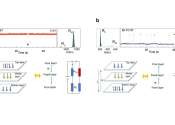Watch tiny electromechanical robots that are faster than cheetahs for their size
A team of researchers at Johannes Kepler University, in Austria, has developed a series of tiny, steerable electromechanical robots that can walk, run, jump and swim at high speeds for their size. In their paper published ...









